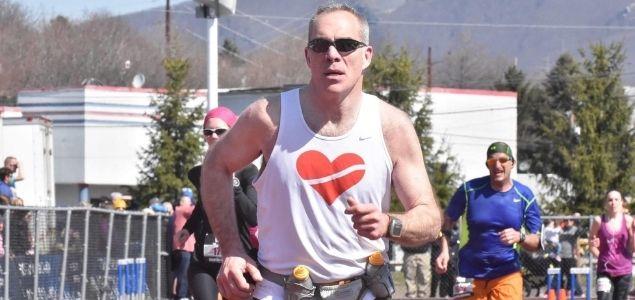
When Third-Party Non-Commercial Compliance Manager Timothy Burke was diagnosed with Relapsing-remitting Multiple Sclerosis (MS) 21 years ago, he began experiencing physical and cognitive difficulties that would come and go. However, instead of letting the disease defeat him, he decided to “outrun MS” by participating in marathons and other endurance events.
Burke began distance training after 11 years with MS. His current training regimen consists of a four-day routine of speed running, short to middle distance running, and long distance running.
“I made the decision that as long as I was running, MS would have to chase me to gain ground,” Burke said.
Exercise can help to ease the symptoms of MS, and Burke engages in plenty of exercise, averaging about 25 miles of running a week. He increases his running distances the closer he gets to a race to help prepare himself for the challenges of a marathon.
Burke has completed six full marathons, having run 26.2 miles in each one. He has also competed in a 51-mile ultra-marathon.
In addition, Burke has also participated in two Olympic distance triathlons, which include 1.5 miles of swimming, 25.5 miles of biking and 6.2 miles of running.
“So far, I have been able to stay ahead of the disease progression and achieve every running goal I’ve set for myself,” Burke said. “I don’t win many races, but every time I cross the finish line, it’s a victory.”
On top of his participation in athletic activities, Burke also serves as a National MS Peer Connection volunteer. His duties include having conversations with those who have recently been diagnosed with MS, and fielding questions from their friends and family.
“[The program] can help those living with MS, as they can get information and reflection from someone who lives with it every day,” said Burke. “I’m always available to answer questions and provide counsel on how to move forward in the shadow of this debilitating disease.”
ABOUT THIS BLOG
Did you know PennDOT is directly responsible for nearly 40,000 miles of highway and roughly 25,000 bridges? We oversee programs and policies affecting highways, urban and rural public transportation, airports, railroads, ports and waterways, in addition to administering the state's more than 11 million vehicle registrations and 8.8 million driver's licenses.
So, how do we do what we do? And how can we help you travel in Pennsylvania — whether it be for business or leisure — in safe and enjoyable manner? Read PennDOT Way to learn more about the department, what we do, and how and why we do it.
TAGS
50-Year Anniversary, 511PA, Aggressive Driving, Airports, Autonomous Vehicles, Bicycles, Bridges, Child Safety, Community Relations, Construction, COVID-19, Distracted Driving, District 1, District 10, District 11, District 12, District 2, District 3, District 4, District 5, District 6, District 8, District 9, DOTcom, Driver and Vehicle Services, Emergency Responders, Employment, Equity, FAQ Friday, Human Trafficking, Impaired Driving, Innovations, Live Free Ride Alive, Maintenance Monday, Motorcycles, Older Drivers, PA Motorcycle Safety Program, Pedestrians, PennDOT Connects, Ports, Public Transit, Railroads, REAL ID, Road MaP, Roadside Beautification, Rural Roads, Safety, School Buses, Seat Belts, State Transportation Innovation Council (STIC), Sustainability, Teen Drivers, Throwback Thursday, Transportation Funding, Travel in PA, Welcome Centers, Winter, Work Smart, Work Zone, Yellow Dot
LATEST POSTS
PennDOT Continues Sharing, Updating Resources for Local Governments to Pursue Bipartisan Infrastructure Law Funding Opportunities
Norwin High School Wins 2024 ‘Innovations Challenge’
Demo Complete: I-95 CAP Project in Center City Philadelphia
PennDOT Archeologist Connects Past, Present, and Future
Lehigh Valley DUI, Highway Safety Task Force Hosts Law Enforcement Seminar
ARCHIVES
2024
2023
2022
2021
2020
2019
2018
2017

